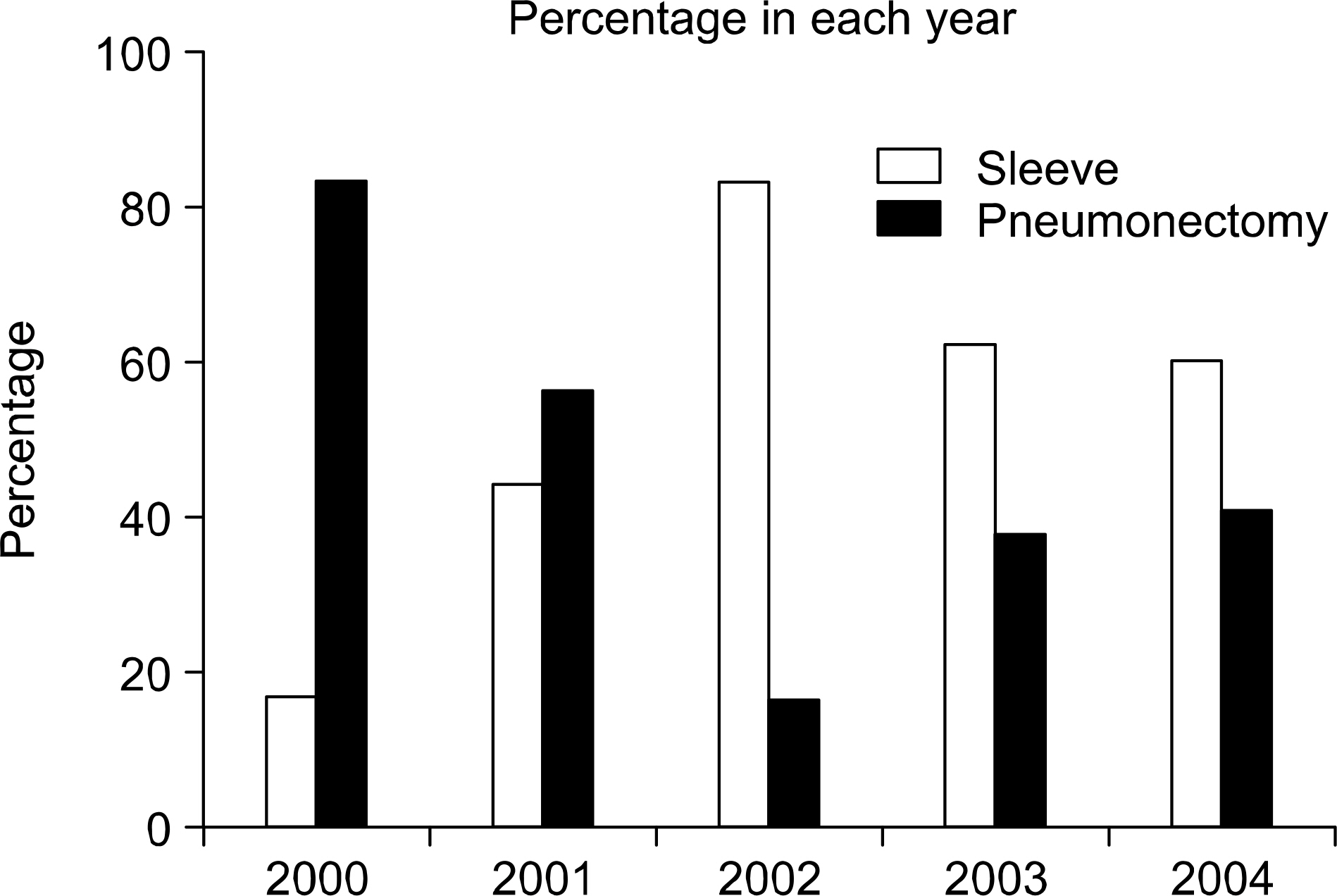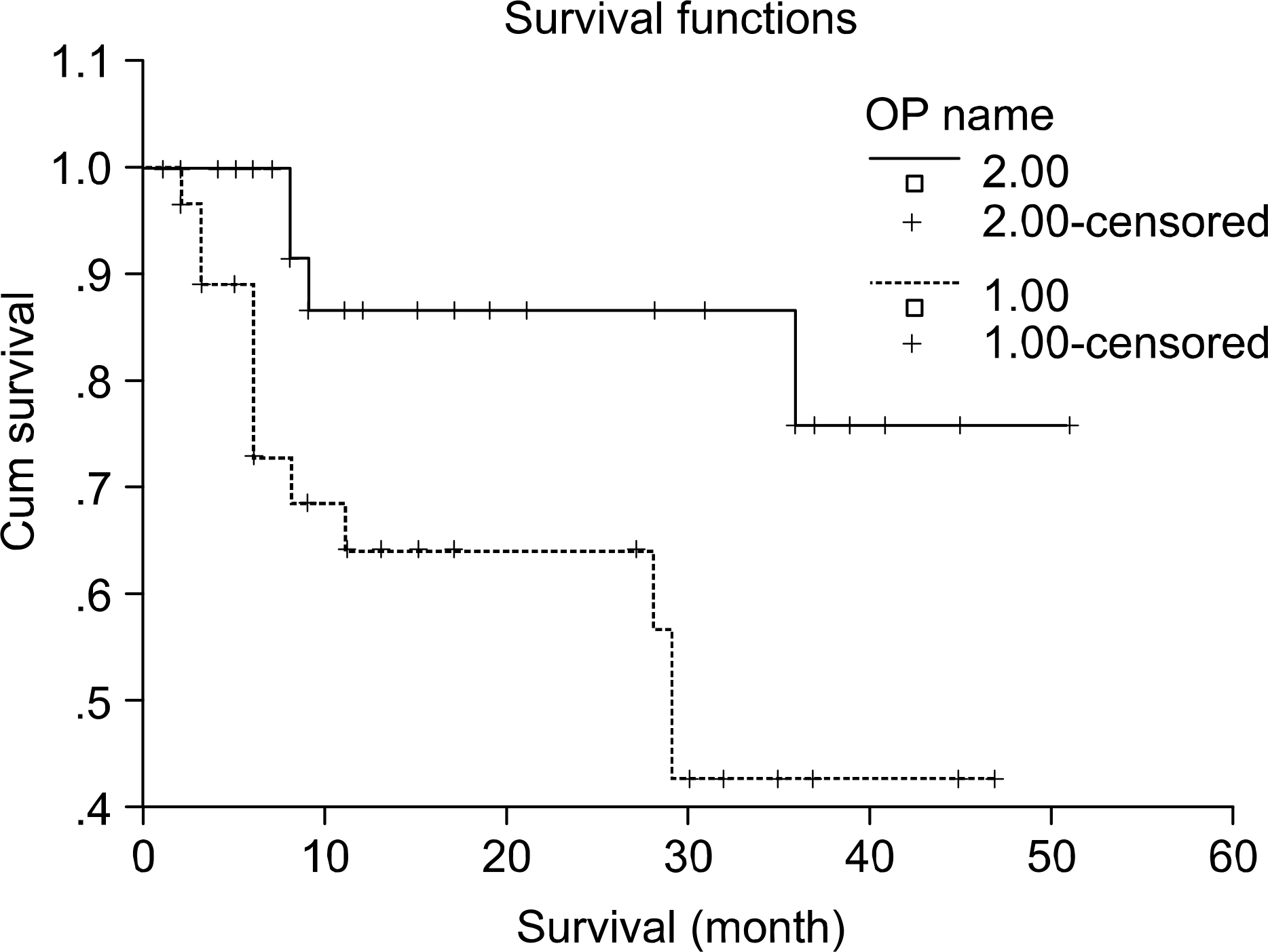J Lung Cancer.
2006 Jun;5(1):23-29. 10.6058/jlc.2006.5.1.23.
Comparison of the Results of Parenchymal Sparing Operation and Pneumonectomy for Non-small Cell Lung Cancer
- Affiliations
-
- 1Department of Thoracic and Cardiovascular Surgery, School of Medicine, Ajou University, Suwon, Korea. choiho@ajou.ac.kr
- KMID: 1881522
- DOI: http://doi.org/10.6058/jlc.2006.5.1.23
Abstract
-
PURPOSE: Parenchymal sparing lung surgery indicated for central tumors for which the alternative is pneumonectomy. Pneumonectomy has a higher perioperative mortality risk than lobectomy. To increase resection rates and improve outcomes we have implemented a policy of parenchymal sparing operation for tumors involving a main stem bronchus and pulmonary artery.
MATERIALS AND METHODS
From January 2000 to May 2004, 30 pneumonectomies and 30 parenchymal sparing procedures were carried out in the Department of Thoracic and Cardiovascular Surgery of Ajou University Hospital. Suvival and complications were analyzed and compared. Parenchymal sparing operation was always done when technically possible. Thus pneumonectomy was reserved for lesions that could not be removed by a parenchymal sparing operation.
RESULTS
There were no significant inter-group differences in perioperative course or outcome and patient characteristics except postoperative stage. One year survival was 56.7% after pneumonectomy and 86.7% after parenchymal sparing operation. The rate of pneumonectomy decreased significantly with increasing experience of parenchymal sparing operation with 21 of the last 32 patients (66%) avoiding pneumonectomy.
CONCLUSION
We suggested that as a curative treatment, parenchymal sparing operation may be a safer procedure than pneumonectomy without adversely affecting outcome. Pneumonectomy can be avoided in a large proportion of patients with non-small cell lung cancer
Figure
Reference
-
1.Graham EA., Singer JJ. Successful removal of an entire lung for carcinoma of the bronchus. CA Cancer J Clin. 1974. 24:238–242.
Article2.Price-Thomas C. Conservative resection of the bronchial tree. J R Coll Surg Edinb. 1956. 1:169.3.Allison PR. Lobectomy and bronchial anastomosis in the surgery of bronchial carcinoma. Ann R Coll Surg Engl. 1959. 25:20.4.Johnson JB: Jones PH. The treatment of bronchial carcinoma by lobectomy and sleeve resection of the main bronchus. Thorax. 1959. 14:48–54.
Article5.Tedder M., Anstadt MP: Tedder SD: Lowe JE. Current morbidity, mortality, and survival after bronchoplastic procedures for malignancy. Ann Thorac Surg. 1992. 54:387–391.
Article6.Lowe JE., Sabiston DC Jr. Bronchoplastic techniques in the surgical management of benign and malignant pulmonary lesions. In: Sabiston DC Jr, Spencer FC, editors. Surgery of the chest. Philadelphia: WB Saunders;. 1990. 577.7.Okada M., Yamagishi H., Satake S, et al. Survival related to lymph node involvement in lung cancer after sleeve lobectomy compared with pneumonectomy. J Thorac Cardiovasc Surg. 2000. 119:814–819.
Article8.Okada M., Tsubota N., Yoshimura M, et al. Extended sleeve lobectomy for lung cancer: the avoidance of pneumonectomy. J Thorac Cardiovasc Surg. 1999. 118:710–714.
Article9.Ferguson MK: Lehman AG. Sleeve lobectomy or pneumonectomy: optimal management strategy using decision analysis technique. Ann Thorac Surg. 2003. 76:1782–1788.10.Gaissert HA., Mathisen DJ., Moncure AC, et al. Survival and function after bronchial sleeve lobectomy for lung cancer. J Thorac Cardiovasc Surg. 1996. 111:948–953.11.Rendina EA., Venuta F., de Giacomo T, et al. Parenchymal sparing operations for bronchogenic carcinoma. Surg Clin North Am. 2002. 82:589–609.
Article12.Suen HC., Meyers BF., Guthrie R, et al. Favorable results after sleeve lobectomy or bronchoplasty for bronchial malignancies. Ann Thorac Surg. 1999. 67:1557–1562.
Article13.Lausberg HF: Graeter TP., Wendler 0., Demertzis S: Ukena D., Schafers HJ. Bronchial and bronchovascular sleeve resection for treatment of central lung tumors. Ann Thorac Surg. 2000. 70:367–371.14.Wright CD., Wain JC., Mathisen DJ., Grillo HC. Postpneumonectomy bronchopleural fistula after sutured bronchial closure: incidence, risk factors and management. J Thorac Cardiovasc Surg. 1996. 112:1367–1371.
Article15.Deslauriers J., Gregoire J., Jacques LF, et al. Sleeve lobectomy versus penumonectomy for lung cancer: a comparative analysis of survival and sites or recurrences. Ann Thorac Surg. 2004. 77:1152–1156.16.Rendina EA., Venuta F: Ciriaco P., Ricci C. Bronchovascular sleeve resection. J Thorac Cardiovasc Surg. 1993. 106:73–79.
Article17.Weiser RD., Cooper JD: Delarue NC: Thenan TE: Todd TRJ: Pearson FG. Sleeve lobectomy for carcinoma of the lung. J Thorac Cardiovasc Surg. 1979. 78:830–849.18.Paulson DL., Urschel HC., McNamara JJ., Shaw RR. Bronchoplastic procedures for bronchogenic carcinoma. J Thorac Cardiovasc Surg. 1970. 59:38–48.
Article19.Icard P., Regnard JF., Guibert L, et al. Survival and prognostic factors in patients undergoing parenchymal saving bronchoplastic operatioin for primary lung cancer: a series of 110 consecutive cases. Eur J Cardiothorac Surg. 1999. 15:426–432.20.Martin-Ucar AE: Chaudhuri N., Edward JG., Waller DA. Can pneumonectomy for non-small cell king cancer be avoided? An audit of parenchymal sparing lung surgery. Eur J Cardiothorac Surg. 2002. 21:601–605.21.Cho SK., Sung KI., Lee C, et al. Long term results of bronchial sleeve resection for primary lung cancer, Korean J Thorac Cardiovasc Surg. 2001. 34:917–923.
- Full Text Links
- Actions
-
Cited
- CITED
-
- Close
- Share
- Similar articles
-
- A Case of Combined Small Cell Carcinoma with Non-Small Cell Lung Carcinoma, Adenocarcinoma and Squamous Cell Carcinoma
- Comparison of Operative Mortality and Complications between Bronchoplastic Lobectomy and Pneumonectomy in Lung Cancer Patients
- The Patterns of Recurrence after Surgery for Non-small Cell Lung Cancer
- Surgical Treatment of Recurrent Lung Cancer
- A Case of Dermatomyositis Associated with Non-Small Cell Carcinoma of The Lung



